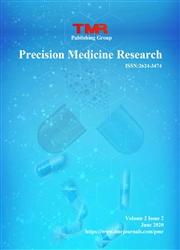Mechanism of Cordyceps sinensis in atherosclerosis treatment based on network pharmacology and molecular docking analysis
引用次数: 0
Abstract
Background: The present study intented to delve into the molecular mechanism of Cordyceps sinensis ( C. sinensis ) in treating atherosclerosis by combining network pharmacology and molecular docking analysis. Methods: We searched the databases including Traditional Chinese Medicines Systems Pharmacology Database and Analysis Platform, PubChem, and PharmMapper to screen out the active chemical ingredients of C. sinensis and the corresponding targets. The String database was used for the matching normalization of results, and the software Cytoscape 3.7.2 was adopted to establish the C. sinensis -active components-targets of action-disease network. The databases of Online Mendelian Inheritance in Man database, GeneCards, Therapeutic Target Database, and DisGNET were searched to yield the major targets of atherosclerosis (AS), which were matched with the active component targets of C. sinensis to identify the potential therapeutic targets. The String database was utilized to set up the protein-protein interaction network, and Cytoscape software was applied for topological analysis, which was followed by the Gene Ontology analysis and Kyoto Encyclopedia of Genes and Genomes signaling pathway analysis based on the DAVID database. Finally, the core components of C. sinensis and the targets of action were confirmed via molecular docking on AutoDock Vina and PyMOL. Results: In total, 7 bioactive ingredients of C. sinensis were identified from Traditional Chinese Medicines Systems Pharmacology Database and Analysis Platform database and 319 predicted targets were obtained, 231 of which were associated with AS. The core targets involved in AS treatment with C. sinensis included MAPK1, SRC, PIK3R1, AKT1, and HSP90AA1. The enrichment analysis unveiled the primary pathways involved in these processes, such as pathways in cancer and lipid and atherosclerosis. Moreover, through molecular docking, it was found that the active ingredients of C. sinensis presented with strong binding capacities with their corresponding targets, and the strongest binding capacity was observed between peroxyergosterol and SRC. Conclusions: The present study revealed at the molecular level that C. sinensis played its role in AS treatment through multiple drug active components, targets of action and pathways, which would point out the direction and provide theoretic basis for future research.基于网络药理学和分子对接分析的冬虫夏草治疗动脉粥样硬化机制研究
背景:本研究拟采用网络药理学和分子对接分析相结合的方法,探讨冬虫夏草治疗动脉粥样硬化的分子机制。方法:检索中药系统药理学数据库及分析平台、PubChem、PharmMapper等数据库,筛选出中华草的有效化学成分及相应的靶点。采用String数据库对结果进行匹配归一化,采用Cytoscape 3.7.2软件建立中华沙棘-有效成分-作用靶点-疾病网络。通过Man数据库、GeneCards、Therapeutic Target database、DisGNET等数据库进行检索,得到动脉粥样硬化(AS)的主要靶点,并与中华c.c sinensis的活性成分靶点进行匹配,确定潜在的治疗靶点。利用String数据库建立蛋白-蛋白互作网络,利用Cytoscape软件进行拓扑分析,然后基于DAVID数据库进行基因本体分析和京都基因与基因组百科全书信号通路分析。最后,通过AutoDock Vina和PyMOL的分子对接,确定了sinensis的核心成分和作用靶点。结果:从中药系统药理学数据库和分析平台数据库中共鉴定出7种中草药活性成分,获得319个预测靶点,其中231个与AS相关。中华梭菌处理AS的核心靶点包括MAPK1、SRC、PIK3R1、AKT1和HSP90AA1。富集分析揭示了参与这些过程的主要途径,如癌症、脂质和动脉粥样硬化的途径。此外,通过分子对接发现,中华c.c sinensis的活性成分与相应靶标具有较强的结合能力,其中过氧角甾醇与SRC的结合能力最强。结论:本研究在分子水平上揭示了中华梭菌通过多种药物活性成分、作用靶点和途径发挥其治疗AS的作用,为今后的研究指明了方向和提供了理论依据。
本文章由计算机程序翻译,如有差异,请以英文原文为准。
求助全文
约1分钟内获得全文
求助全文

 求助内容:
求助内容: 应助结果提醒方式:
应助结果提醒方式:


